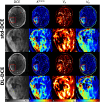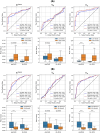Deep learning-based super-resolution and denoising algorithm improves reliability of dynamic contrast-enhanced MRI in diffuse glioma
- PMID: 39455814
- PMCID: PMC11512070
- DOI: 10.1038/s41598-024-76592-7
Deep learning-based super-resolution and denoising algorithm improves reliability of dynamic contrast-enhanced MRI in diffuse glioma
Erratum in
-
Author Correction: Deep learning-based super-resolution and denoising algorithm improves reliability of dynamic contrast-enhanced MRI in diffuse glioma.Sci Rep. 2024 Nov 13;14(1):27828. doi: 10.1038/s41598-024-79468-y. Sci Rep. 2024. PMID: 39537823 Free PMC article. No abstract available.
Abstract
Dynamic contrast-enhanced MRI (DCE-MRI) is increasingly used to non-invasively image blood-brain barrier leakage, yet its clinical utility has been hampered by issues such as noise and partial volume artifacts. In this retrospective study involving 306 adult patients with diffuse glioma, we applied deep learning-based super-resolution and denoising (DLSD) techniques to enhance the signal-to-noise ratio (SNR) and resolution of DCE-MRI. Quantitative analysis comparing standard DCE-MRI (std-DCE) and DL-enhanced DCE-MRI (DL-DCE) revealed that DL-DCE achieved significantly higher SNR and contrast-to-noise ratio (CNR) compared to std-DCE (SNR, 52.09 vs 27.21; CNR, 9.40 vs 4.71; P < 0.001 for all). Diagnostic performance assessed by the area under the receiver operating characteristic curve (AUROC) showed improved differentiation of WHO grades based on a pharmacokinetic parameter [Formula: see text] (AUC, 0.88 vs 0.83, P = 0.02), while remaining comparable to std-DCE in other parameters. Analysis of arterial input function (AIF) reliability demonstrated that [Formula: see text] exhibited superior agreement compared to [Formula: see text], as indicated by mostly higher intraclass correlation coefficients (Time to peak, 0.79 vs 0.43, P < 0.001). In conclusion, DLSD significantly enhances both the image quality and reliability of DCE-MRI in patients with diffuse glioma, while maintaining or improving diagnostic performance.
Keywords: Deep learning; Glioma; Image enhancement; Magnetic resonance imaging; Perfusion.
© 2024. The Author(s).
Conflict of interest statement
The authors declare no competing interests.
Figures





Similar articles
-
Improving the Reliability of Pharmacokinetic Parameters at Dynamic Contrast-enhanced MRI in Astrocytomas: A Deep Learning Approach.Radiology. 2020 Oct;297(1):178-188. doi: 10.1148/radiol.2020192763. Epub 2020 Aug 4. Radiology. 2020. PMID: 32749203
-
Dynamic contrast-enhanced and dynamic susceptibility contrast perfusion MR imaging for glioma grading: Preliminary comparison of vessel compartment and permeability parameters using hotspot and histogram analysis.Eur J Radiol. 2016 Jun;85(6):1147-56. doi: 10.1016/j.ejrad.2016.03.020. Epub 2016 Mar 22. Eur J Radiol. 2016. PMID: 27161065
-
Textural features of dynamic contrast-enhanced MRI derived model-free and model-based parameter maps in glioma grading.J Magn Reson Imaging. 2018 Apr;47(4):1099-1111. doi: 10.1002/jmri.25835. Epub 2017 Aug 28. J Magn Reson Imaging. 2018. PMID: 28845594
-
Dynamic Contrast-Enhanced (DCE) MRI.Magn Reson Imaging Clin N Am. 2024 Feb;32(1):47-61. doi: 10.1016/j.mric.2023.09.001. Epub 2023 Oct 6. Magn Reson Imaging Clin N Am. 2024. PMID: 38007282 Review.
-
Leveraging deep learning for improving parameter extraction from perfusion MR images: A narrative review.Phys Med. 2025 May;133:104978. doi: 10.1016/j.ejmp.2025.104978. Epub 2025 Apr 11. Phys Med. 2025. PMID: 40215839 Review.
Cited by
-
Imaging markers of neuroinflammation in aging and Alzheimer's disease and related dementia: A comprehensive review.Neurosci Biobehav Rev. 2025 Sep;176:106270. doi: 10.1016/j.neubiorev.2025.106270. Epub 2025 Jun 25. Neurosci Biobehav Rev. 2025. PMID: 40578495 Review.
-
Dual branch attention network for image super-resolution.Sci Rep. 2025 Aug 8;15(1):29019. doi: 10.1038/s41598-025-97190-1. Sci Rep. 2025. PMID: 40781557 Free PMC article.
-
Deep learning enhances reliability of dynamic contrast-enhanced MRI in diffuse gliomas: bypassing post-processing and providing uncertainty maps.Eur Radiol. 2025 Apr 19. doi: 10.1007/s00330-025-11588-z. Online ahead of print. Eur Radiol. 2025. PMID: 40252095
-
Can diffusion-based generated magnetic resonance images predict glioma methylation accurately?Quant Imaging Med Surg. 2025 Jun 6;15(6):5647-5659. doi: 10.21037/qims-24-1688. Epub 2025 May 21. Quant Imaging Med Surg. 2025. PMID: 40606391 Free PMC article.
References
-
- Cuenod, C. & Balvay, D. Perfusion and vascular permeability: Basic concepts and measurement in dce-ct and dce-mri. Diagn. Interv. Imaging94, 1187–1204 (2013). - PubMed
-
- Khalifa, F. et al. Models and methods for analyzing dce-mri: A review. Med. Phys.41, 124301 (2014). - PubMed
-
- Sourbron, S., Ingrisch, M., Siefert, A., Reiser, M. & Herrmann, K. Quantification of cerebral blood flow, cerebral blood volume, and blood-brain-barrier leakage with dce-mri. Magn. Reson. Med. Off. J. Int. Soc. Magn. Reson. Med.62, 205–217 (2009). - PubMed
-
- Tofts, P. S. et al. Estimating kinetic parameters from dynamic contrast-enhanced t1-weighted mri of a diffusable tracer: Standardized quantities and symbols. J. Magn. Reson. Imaging Off. J. Int. Soc. Magn. Reson. Med.10, 223–232 (1999). - PubMed
-
- Hylton, N. et al. Dynamic contrast-enhanced magnetic resonance imaging as an imaging biomarker. J. Clin. Oncol.24, 3293–3298 (2006). - PubMed
MeSH terms
Substances
Grants and funding
- No. 2021M3E5D2A01022493/National Research Foundation of Korea
- No. RS-2023-00251022/National Research Foundation of Korea
- 20011878/Ministry of Trade, Industry and Energy
- Phase III (Postdoctoral fellowship) grant of the SPST (SNU-SNUH Physician Scientist Training) Program/College of Medicine, Seoul National University
- No. 04-2023-2050/Seoul National University Hospital
LinkOut - more resources
Full Text Sources
Medical
Research Materials

